THE BOERUM HILL SNAKE-OIL MAN (1885)
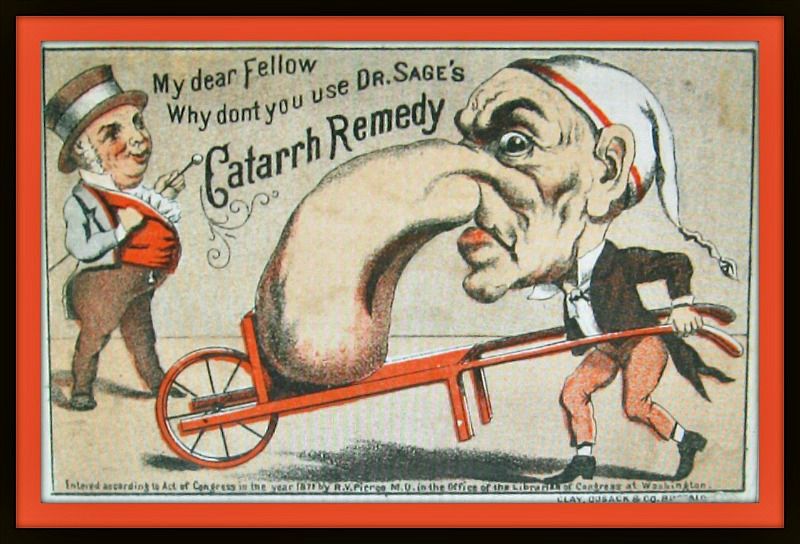
Brownstone Detectives investigates the history of our clients’ homes.
The story you are about to read was composed from research conducted in the course of one of those investigations.
Do you know the history of YOUR house?
********************************************************************************************************************************
If you climbed to the third floor of 375 Pacific Street in 1885, two floors above its stable, and you passed through “several mysterious little doors,” you might find “a little room where seven girls were busily engaged” in filling and labeling numerous clear bottles.
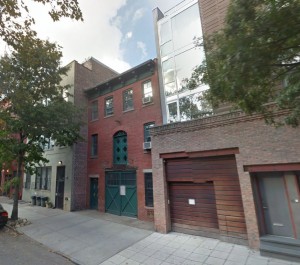
And if you thought, while climbing the thin stairway and passing through the oddly small doors, that perhaps you were entering upon the quarters of a crime syndicate or those of a mafia den, you would not have been too very far from the truth.
MAKING, BOTTLING, AND SELLING THE CURE
Years before the Pure Food and Drug Act was signed into law in 1906, patent medicine salesmen were plying the U.S. mails with great success. Although their “cures” brought their clients considerably less success, their hopes were still strong and snake oil continued to sell at a good clip. Patent medicine salesmen were everywhere, advertising everywhere, and came from a number of professions – failed doctors, teachers, tinsmiths, and even wood engravers.
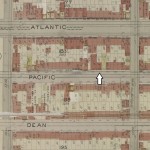
What a wood engraver might have known about medicine was probably never in dispute – all he needed to know was how to sell a product – what was in dispute was the fact that his “cure” did nothing other than make the buyer somewhat poorer.
That wood engraver, “Dr. J. A. Lawrence,” who was otherwise known as James L. Connolly, a “stylishly well-dressed young man” who had his shop at 375 Pacific Street, and hired the names of numerous doctors in the pursuit of riches, made at least $100,000 a year of clear profit selling his nostrums.
How did a wood engraver makes hundreds of thousands of dollars in the 19th century selling worthless tonics?
He gave it away – FREE.
THE GULLIBILITY OF THE MASSES
Whether people in the 19th century were more gullible than they are today it is not known, but, as Barnum once said about his patrons, “There is a sucker born every minute.”
And our engraver proved that rule countless times.
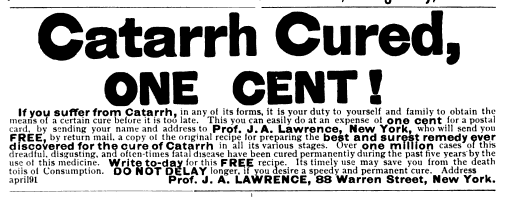 But his sales technique was so clever, so easy to implement, yet so intricate, that it was like his laboratory which seemed like a house on the outside, but was really a warren of doors on the inside.
But his sales technique was so clever, so easy to implement, yet so intricate, that it was like his laboratory which seemed like a house on the outside, but was really a warren of doors on the inside.
Here is how it worked:
Connolly would place an advertisement into any number of newspapers, trade magazines, women’s journals, or other such publications around the country.
In his ad, he not only claimed that his catarrh remedy has cured “one million” cases of catarrh, but that if the gentle reader would simply send his or her name and address to the good doctor, then he would send them “by return mail, a copy of the original recipe for preparing the best and surest remedy ever discovered for the cure of Catarrh in all its various stages” – free of charge.
…AND THEN THE OTHER SHOE DROP’D
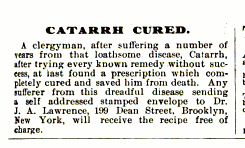 When the catarrh sufferer – and they suffered, all right (catarrh produced a singularly vile form of mucous in the ear and throat canals which caused all sorts of irritating conditions, including, but not limited to, the discharge of the vile and foul-smelling substance from the ears, nose and mouth) – received a recipe in the mail which included ingredients such as Arabian Sea Grass (pulverized), Arabian Kanke Root (pulverized, of course), Bugle Leaves (yes, pulverized), Chlorate Quinia, &c., and the list went on.
When the catarrh sufferer – and they suffered, all right (catarrh produced a singularly vile form of mucous in the ear and throat canals which caused all sorts of irritating conditions, including, but not limited to, the discharge of the vile and foul-smelling substance from the ears, nose and mouth) – received a recipe in the mail which included ingredients such as Arabian Sea Grass (pulverized), Arabian Kanke Root (pulverized, of course), Bugle Leaves (yes, pulverized), Chlorate Quinia, &c., and the list went on.
While such ingredients might be unfamiliar to us nowadays, such recipes were easily brought to the corner drugstore in the day, where the pharmacist would create the brew necessary to cure the sickness at the root of the client’s symptoms.
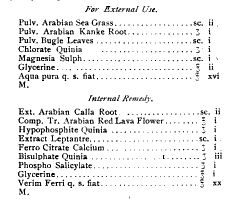
In every case, though, where Dr. J. A. Lawrence’s recipe was brought to a chemist, the chemist would invariably reply:
“There is an article or two within your recipe which is a patent ingredient to which we do not have access.”
At this point, the client would write back to the good doctor and ask:
“Where, o where on this good green earth might such an ingredient be found?”
To which, the good doctor would kindly respond:
“If you cannot procure this ingredient in your area, I will gladly send you a bottle of the “Arabian Cure for Catarrh….for $3.”
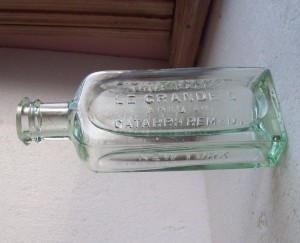
Now, many clients of Dr. Lawrence might, at this point, throw in the towel and realize this as a swindle which could only involve their great loss of money. Other catarrh sufferers, though, who’ve had little success with any other regular treatments and were desperate to find that golden cure, would send the money to Dr. Lawrence and hope for the best.
In a few weeks, they would receive a bottle of “Le Grande’s Arabian Cure for Catarrh,” which, it was claimed, was effective “for the cure of catarrh, bronchitis, hay fever and all diseases of the mucous membrane.” The hopeful recipient, however, would soon find out that not only did the “cure” not work, but that it was a perfectly worthless compound which contained nothing it was claimed to possess.
THE BROOKLYN POST OFFICE POLICE TAKE CHARGE
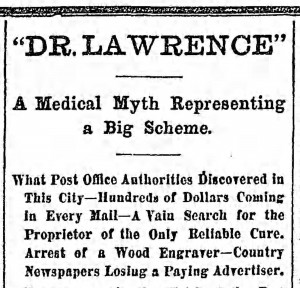
When hundreds of letters came to the General Post office in Brooklyn, all addressed to “Dr. J. A. Lawrence,” collected by James L. Connolly on a daily basis, the powers that were at the post office began to become suspicious that all was not right with the good doctor.
In short order they began their attempts to find Dr. Lawrence, getting an inspector from Washington and an assistant attorney general involved. But again, these two men would find their path to resemble that to Connolly’s laboratory at the top floor of the stable building on Pacific Street.
Eventually, though, they realized that they were not looking for a doctor, but for Connolly himself. An arrest warrant was issued and soon Connolly was apprehended. Connolly, of course, denied everything, insisting that he was simply a lowly wood engraver.
Yes,” the inspector must have answered, “a very RICH wood engraver, at that!”
Connolly was arrested. Then he quickly filed a civil lawsuit against the government for detaining his mail.
DR. LAWRENCE BEATS THE POSTMASTER

And here is how it ended:
Connolly must have thought he’d gotten a late Christmas present when the judge returned to him a “not guilty” verdict.
While the case was certainly not to end there, the Brooklyn postmaster learned that “there is no law empowering the Postmaster to detain any letter whether it is addressed to a fictitious person or not.”
“The government,” the referee continued, “undertakes to deliver the letter when it accepts it, and delivery is not complete until the letter is in the hands of the person to whom it is addressed.’
Merry Christmas, Dr. Lawrence – Merry Christmas, indeed.
———————————————————————————————————————–
 Brownstone Detectives is an historic property research agency. Our mission is to document and save the histories of our clients’ homes. From our research, we produce our celebrated House History Books and House History Reports. Contact us today to begin discovering the history of your home.
Brownstone Detectives is an historic property research agency. Our mission is to document and save the histories of our clients’ homes. From our research, we produce our celebrated House History Books and House History Reports. Contact us today to begin discovering the history of your home.